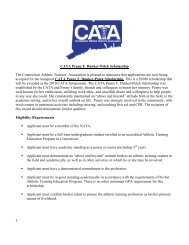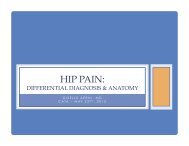The Sportsman's Hernia - The Connecticut Athletic Trainers ...
The Sportsman's Hernia - The Connecticut Athletic Trainers ...
The Sportsman's Hernia - The Connecticut Athletic Trainers ...
Create successful ePaper yourself
Turn your PDF publications into a flip-book with our unique Google optimized e-Paper software.
<strong>The</strong> Sportsman’s <strong>Hernia</strong> John Bonadies, MD, FACS Co-‐Founder, <strong>Connecticut</strong> <strong>Hernia</strong> Center Hamden/Guilford/Ansonia, CT
Aldo helps with homework
Sound familiar? Track, hockey, lacrosse, soccer, football, softball, waterskiing Groin Pain Don’t always recall a specific “moment” of injury. Commonly noted the following day or next workout Pain relieved with rest Pain returns with return to activity Even after extended inactivity Commonly at same time interval in jog or workout Non-‐athletes? Shoveling snow/slipping or falling Postpartum?
History 1956, French anatomist and surgeon Fruchaud described posterior laxity of transversalis fascia 1988, Gullmo suggested pain may be related to peritoneal distension or stretching of the ilioinguinal nerve
History 1992, British surgeon Dr. Jerry Gilmore Treated three footballers unable to play because of chronic groin pain Gilmore’s Groin <strong>Athletic</strong> pubalgia Sports or Sportsmen’s <strong>Hernia</strong> Symphysis Syndrome Posterior Wall Deficiency
A Renaissance 1996 <strong>The</strong> sportsman’s hernia—fact or fiction? Scand J Med Sci Sports 1999 40 references in a Medline search 2005 No papers or references at the American <strong>Hernia</strong> Society Few results with internet searches Today Entire sessions dedicated at the International <strong>Hernia</strong> Society Over 4 million results on Google search
ESPN http://www.youtube.com/watch?v=JXn4NggRz4k
Anatomy Abdominal wall Bony pelvis Inguinal canal Nerves Ilioinguinal Genitofemoral Direct <strong>Hernia</strong>s Indirect <strong>Hernia</strong>s
Anatomy
True <strong>Hernia</strong>s
Anatomy 3
Anatomy Ilioinguinal/iliohypogastric nerves
Anatomy Genitofemoral Nerve
Pathophysiology <strong>The</strong> Pubic Joint? Imbalance between adductors or hip flexors and oblique/rectus axis
PresentaIon
Physical Exam Tender over inguinal floor esp at pubic tubercle No mass but discomfort with strain (Valsalva) May have bulge with tnderness upon impact w examining finger May have tenderness at symphysis (midline) Osteitis pubis?
Physical Exam Positive Straight Leg Raise Ipsilateral/contralateral Antigravity/ added resistance Sit up sign +/-‐ resistance Adductors Function Tenderness at insertion w pubic ramus
Imaging Ultrasound To diagnose occult true inguinal hernia Reports of floor laxity 2 cm protrusion with valsalva MRI Predominantly negative Rule in/out alternative diagnoses Osteitis pubis Hip flexor injury Torn labrum
Treatments Non operative Rest, rest, rest NSAIDS Hot/cold Operative Anterior repairs Munich Posterior repairs Laparoscopic Nerve transection Adductor tenolysis
Surgery “Munich” Repair Dr. Ulrike Muschaweck Open anterior repair, non-‐mesh Local anesthesia/sedation Suture butressing or posterior wall +/-‐ sacrifice of genital branch of genitofemoral nerve Early post-‐op mobility
Surgery “Munich” Repair
Surgery “Munich” repair
Surgery Laparoscopic TEP Outpatient, general anesthetic Minimally invasive Periumbilical incision Allows for full evaluation of inguinal floor Bilateral evaluation/rx thru same incisions
Laparoscopic TEP repair
Laparoscopic TEP repair
Laparoscopic TEP repair
Findings at Surgery Laparoscopic View Occult true hernia 10% in some series Direct space laxity (Hasselbach’s triangle)
Post-‐op Course
OperaIve vs Non-‐OperaIve Paajanen, et al. Surgery 2011. Finland 60 athletes randomized to lap TEP vs PT, NSAIDS and cortisone injections 3-‐6 mos of groin symptoms 90% of operated returned to full activity in 3 mos vs 27% Pain scores better at 1-‐12 months
Results Munich repair
Results Israel 2004
Personal Experience
Case 2 33 yo male with 6 mos of L groin pain Non athlete No recall of specific injury incident Lifting heavy boxes Worse w hip flexion, prolonged standing Up stairs, in/out of car PE Tender pubic tubercle ++straight leg raise and situp, worse w resistance MRI negative
Case 3
Summary Sportsman’s <strong>Hernia</strong> Real injury(s) Infancy in understanding and diagnosing Clinical diagnosis Straight leg raise and resisted sit-‐up Not just for athletes Probably multiple distinct injuries Posterior wall injury/laxity Commonly concomitant
Summary Sportsman’s <strong>Hernia</strong> Surgery yields quicker return to full activity Early mobilization possible More investigations needed Imaging Optimal post-‐op therapy? Role of nerve ablation? Role of adductor tenolysis? Munich vs. Lap TEP? Lightweight meshes? Osteitis pubis?








